Drive-By Gardens: Rockin’ alternative lawns in north Austin
Driving around north Austin last week, I spotted quite a few nontraditional front yards, where the owners had traded in the typical expanse of St. Augustine or Bermuda for a smaller plot of grass, a sedge lawn, or a garden instead of lawn. No matter the style, every one expressed the individuality of the homeowner, which is something that a traditional lawn can never do.
Pictured above is a modern garden with a reduced lawn that occupies only about one-fourth of the yard. Elevated with a rusted-steel edge, this plush throw-rug of grass (what kind, I wonder?) is set off like a work of art. It also acts as negative space and a welcome block of color.
Taking up nearly half the space is a gravel parking strip/entry path, with offset, rectangular slabs of concrete leading visitors to the elevated lawn. I find it a little odd to direct visitors to slog across a lawn because one’s feet always get wet or heels sink into the soil; plus, if you have many visitors, they’d wear out the grass in the middle. I like a solid-surface path, myself. But it’s certainly an interesting approach, and I do enjoy seeing something different.
A low, horizontal-board fence (dubbed a hipster fence by my friend David Cristiani) on either side of the lawn separates the public space from the private. Behind it on the left, you can just spot a circular gravel patio encircling a tree. On the right, a rectangular space paved in Texas Black gravel can be seen in the 2nd photo above.
A quieter, more meditative design has just been installed in the front yard of one of my neighbors. Under a half-dozen live oaks, which shaded out the former St. Augustine lawn (the drought turned the last blades to dust), newly planted plugs of Texas sedge will eventually fill in to create a tufty “lawn.” Large boulders set in gravel provide a vaguely Asian-style focal point. On the left (not visible), a few shade-tolerant palms offer contrasting height and texture.
Infill construction a few years ago created this colorful contemporary-storybook house—or at least that’s how I think of it. The tiny front yard could easily have been sodded and forgotten about, but instead the owner created a xeric cottage-style garden with an exuberance of plants and color.
Short pillars of river stone capped with Craftsman-style lights clearly mark the entry and function much the way an arbor would—defining public vs. private space, and offering an invitation for visitors. They also, of course, illuminate the front walk at night.
The walk itself is composed of trios of textured concrete pavers set in Texas Black gravel. It curves invitingly through the garden to the front door.
Looking to the right, a side path traverses the front of the house, leading through the garden to the side fence.
This colorful garden just begs you to explore it—or at least admire it from the sidewalk. Could a standard lawn do that?
All material © 2006-2012 by Pam Penick for Digging. Unauthorized reproduction prohibited.


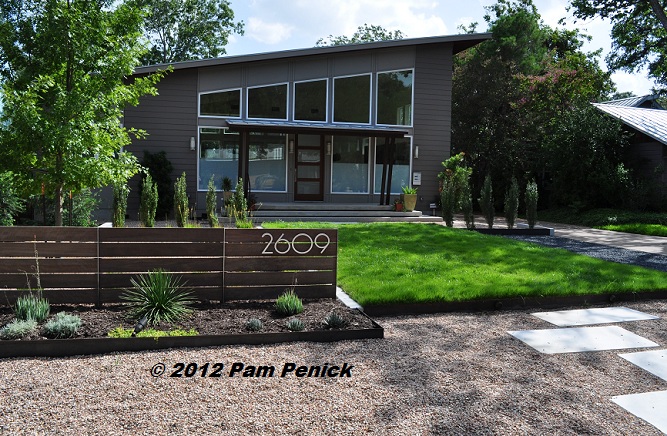
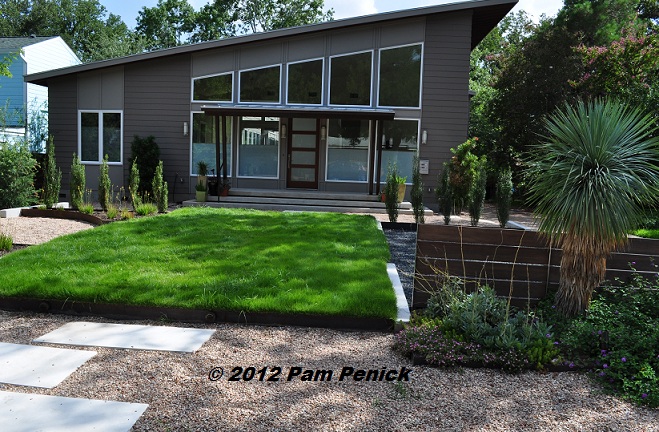
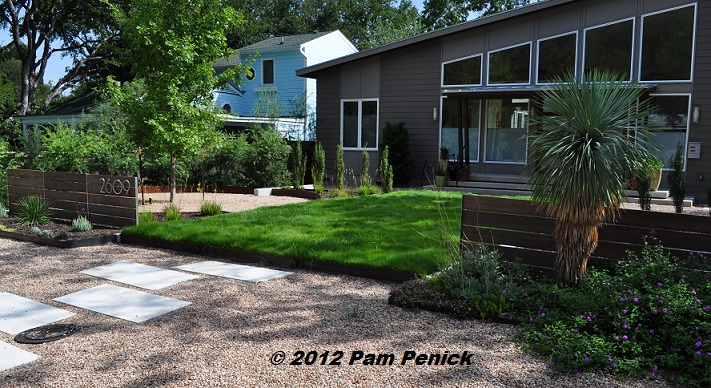
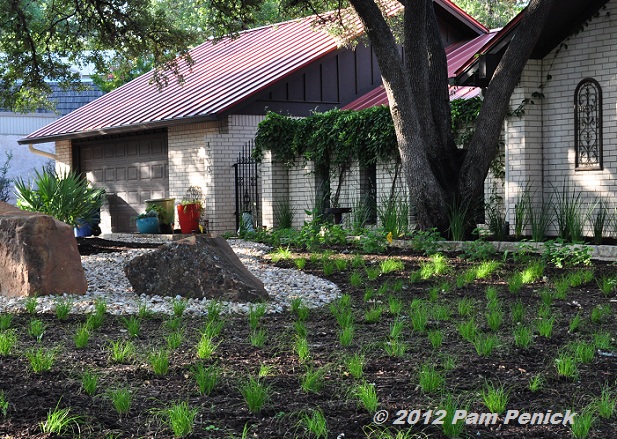
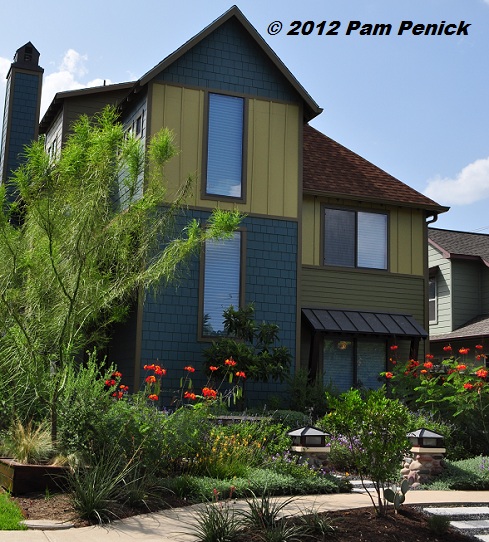
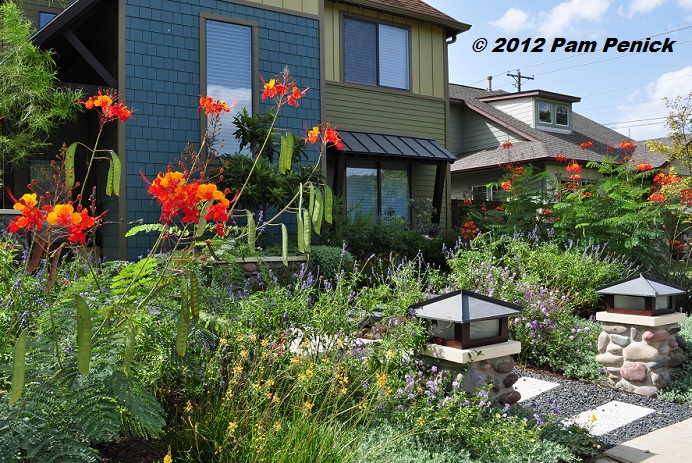
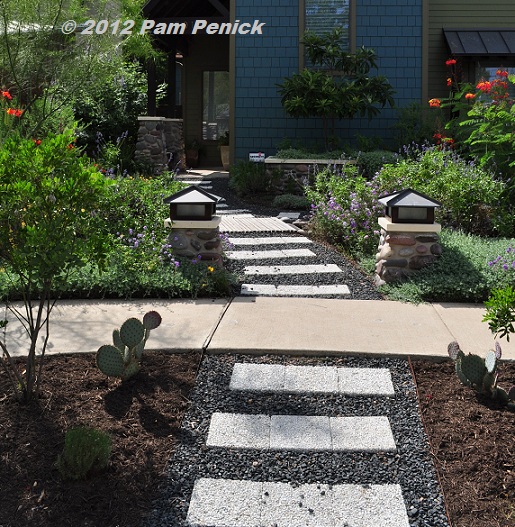
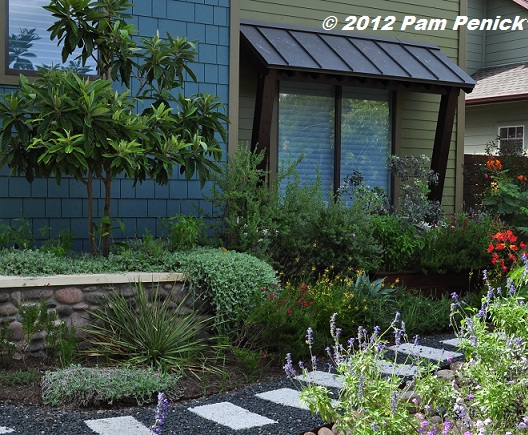
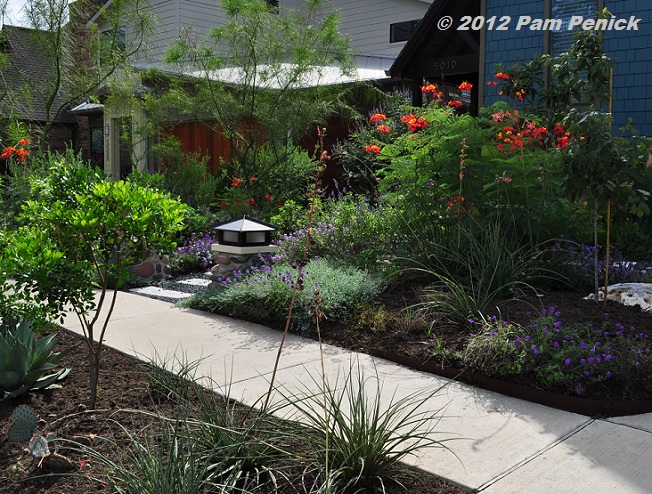
So beautiful, each one. I’ve notice more homeowners removing grass and replacing with pathways and gardens, as well. Frustratingly though, I’ve observed new St. Augustine turf installed where grass died from last year’s drought. Ugh. One garden, one house at a time, I guess.
More and more people are getting that huge expanses of St. Augustine grass aren’t sustainable here anymore—not with off and on drought and mandatory watering restrictions. That’s encouraging, even though it does seem a head-slap moment when someone whose lawn died decides to replace the whole, darn thing. —Pam
House #1 seems to be set up to repel visitors vs. invite them in with the green lawn entry. Personally I wouldn’t walk across it to enter the home for the reasons you mentioned. It is intentionally offputting (bad word choice here)IMHO.
I can see your point of view, Shannon, and share your disinterest in walking through lawn grass to find the front door. But I think overall this garden is welcoming: the wide gap between the fencing says hello, and the fun, zig-zagging path from the street to the lawn is inviting as well. They just seem to have overlooked making a path through the lawn. I wonder if theater buffs live here. The design reminds me of a theater, with the grass as a stage and the fences standing in for velvet curtains. —Pam
I really like all of these non-lawns. Maybe people use the driveway as a path to the front door instead of walking through the grass. I can see your point of sinking into the lawn and picking up all sorts of debris to bring into the house. I like the look of it though. I am itching to do something different in front of our house. This drought just might be a blessing in disguise.
I hope you find the silver lining in the drought you’re suffering through in Indiana, Lisa. The chance to try something new and different is a great way to look at it. —Pam
When I saw the photo of the house at the top my first thought was “love it” and then secondly “why no pavers in the grass?”…odd! That was one of my top priorities in our back garden, get a pathway in the lawn so people don’t have to get their feet wet on the way to the patio (or beat down a path in the lawn). In this case I’m guessing it was all about the look with no thought to the reality.
I dream of replacing the collection of other peoples fences that enclose our back garden with a nice tall dark “hipster fence”…
Those hipster fences (as I shall forever refer to them, thanks to David) are hot, hot, hot in Austin. One would look great in your garden, but you have such a thick, green screen already, it’s hard to imagine that you need it. —Pam
I love all 3 houses, they’re great for inspiration, but,I’m having trouble finding alternatives to our front lawn which has a very steep incline up to our house.I don’t want to re-do it ‘terraced,’ and also if I use gravel etc, I’m afraid they’ll be washed down to the curb.Does anyone else have the same problem? Any photos you might have would be greatly appreciated.Thank you
Terracing helps tame a steep slope like yours, Mirgun, giving plants a place to take hold and also allowing rainwater to soak in rather than sheeting off your lot. If you opt not to terrace, you can still plant (deep-rooted ornamental grasses like Mexican feathergrass and Lindheimer muhly, accented with yuccas and agaves would be a good choice, to anchor the soil), but you’ll find it hard to keep plants watered, and rainfall won’t easily soak in, making it harder to keep your plants alive. Plus, as you point out, soil, gravel, and mulch may wash away during heavy downpours. I suggest you read Sunset Hillside Landscaping for ideas. Good luck! —Pam
I prefer the second house. I lot more interest.
More and more people here are changing out grass for something else. Most are going with some hardscapes of stone…walkways and beds. Some are good…some not so much. Some have put in plantings that can stand the heat and drought and, of course, our voracious deer.
At least, people are beginning to try.
Yes, they are. It’s exciting to see new gardens popping up around town. —Pam
The first photo turfgrass looks like zoysia. I agree in that the pavers similar to the ones already there would have been more functional. I curious who the supplier might be for the corten steel.
I would like to know that too, Greggo. I often have clients wanting to add Corten walls, edging, or planting boxes to their gardens. —Pam
I love the the third yard. So lovely it makes me want to linger in their garden and see what is hiding behind the larger plants. There is also a lot of texture.
Yes, I’d like to tour this one up close too, and I bet the back garden is nice too. —Pam
I’m so delighted that you have taken on the mission of educating people about lawn alternatives. Lawns, treated with chemicals and copious amounts of water remain toxic deserts to wildlife and are SOO boring to humans while using precious water and allowing runoff.
I’m looking forward to buying your book for Christmas presents for some of my gardening friends.
And me; I solved my lawn problem by becoming a nomad. But I really miss my garden.
Oh, Marilyn, thank you for your support! I really appreciate it! Writing this book has indeed set me on a mission of showing people the many alternatives to lawns. I bet you do miss your garden, but I hope you have at least a small portable one to carry around with you. —Pam
For # 5 above: I have NO terracing in my yard. – ZERO. I adore the Ponytail spreading plant- silver gray green leaves- VERY hardy. If I had any terrace at all – that is what I would plant in abundance. Of course, I don’t know about losing soil, mulch etc. But it would be a beautiful start or addition.
Good luck !
I bet you’re talking about silver ponyfoot, right, Shelley? It IS a beautiful groundcover for gravelly gardens, although I hear that deer find it tasty. —Pam
haha well I must be a hipster – please no! – because I LOVE the “hipster” fence. Better yet are the house numbers on that fence! The use of yucca rostrata next to it is perfect. The boldness of the yucca and the accented architectural details of the house are all appropriately tied in IMHO.
Those are FAB house numbers, I agree. And I really like that Yucca rostrata as a punctuation point beside the fence too. —Pam
I love the first house and garden, though I can see how it is not quite practical. Maybe they like riddles. How to make it into the house without loosing your heels on the lawn. The last house is gorgeous. I have been thinking of putting down gravel, and I like the idea of making paths with pavers through the gravel, but am not sure how need and tidy the gravel actually stays. How do you clean it from leaves and other debris? How do you keep the weeds down? (landscape fabric?)
I have gravel paths under live oaks, Ruth, and they do collect fallen leaves. I don’t obsess about it, but a couple of times a year I blow them out with my electric blower. I use landscape fabric only to keep aggressive live oak suckers at bay (with very limited success, I might add). I don’t think I’d bother otherwise unless I had plants nearby with aggressive rhizomes. After all, weed seeds can still blow in and take root in the top portion of your gravel, which landscape fabric does nothing to prevent. Thoroughly removing weeds and grass before you make your path, and staying on top of any weeds that later pop up in the path, is the key. —Pam
Love that last one…it manages to be both interesting and welcoming, with a wealth of visual interest. I can’t wait to see what your neighbor’s yard looks like once it’s filled in…it’s going to be great!
Yes, if they keep it watered. I’m seeing signs of dryness over there already, I’m afraid. So many people think drought-tolerant means they don’t have to water, even to get plants established. —Pam
Hi Pam,
Great finds and a nice sampling for people searching for lawn alternatives. I like all 3! I’m getting ready to do a similar post of some Houston non-lawns, half lawns, gravel ‘lawns’ and my first encounter with a syn-lawn. I’m trying to give the post a very positive spin, but I can’t seem to get past my overwhelming confusion and horror of someone putting in a syn-lawn in our neighborhood. I’ve spent way too many hours grappling with this subject. The companies that make them advertise low maintenance and water savings. But that’s true of gravel and sedge lawns as well. Plus, the stuff heats up just as if it were concrete. My favorite part is that it comes in different ‘types’ of grass so you can pick out your own style! I guess I could imagine someone in a desert city like El Paso doing this. But Houston gets about 50 inches of rain a year and that’s plenty for lawns or to play around with other “real” plants and landscaping. And I do wonder what’s next,synthetic agaves and cacti to accessorize our syn-lawns?
David/:0)
I hear you, David. I researched syn lawns for my upcoming book and found that, for the homeowner who absolutely insists on having a lawn, there are plenty of pros and cons associated with both real grass and fake. I agree that an artificial lawn makes little sense in a climate with as much rainfall as Houston’s, but I can see the point in a more-arid city. I’ve walked across a pretty nice one (but not in the heat of summer—and they do get hot!). Meanwhile, I’ve already seen fake agaves and cacti—made of rusty metal—accenting rock-filled yards here in Austin. Nooo! I like metal agave and cactus sculptures when used as ART, but not when used INSTEAD of real plants. —Pam
Funny that people are ripping out St. Augustine there for not being drought tolerant, it is one of the varieties we recommend as being drought tolerant. I guess it is all relative.
I really like house #1, though I am not minimalist myself. The fullness of house #3 was more to my taste.
It’s relative here too, Les. In shade, a non-pampered St. Augustine lawn can hold its own, even during a dry spell. But it’s often planted in full sun, where it turns brown pretty fast during a drought like we endured last year, and during which we were under mandatory watering restrictions of once a week. That’s fine for a shady lawn. But not for St. Augustine in the sun. —Pam
Love that last garden and house!
It looks like a fun garden to explore, doesn’t it? —Pam
Like the second one but LOVE the third one with the variety, colors, movement and textures… it had everything!
Yes, it looks like a real gardener’s garden. —Pam
All of them are really a nice change from the boring, water-guzzling, neatly manicured rectangle of grass! We have a neighbor who wins yard of the month constantly because she has jumped off the grass lawn edge and landscaped with a variety of plants. She also landscapes around our bus stop…and it’s gorgeous! The sad side of this is that so many neighborhoods are controlled by hide-bound HOAs. The HOAs not only forbid alternative landscaping, but fine you–even during droughts!!–if your lawn isn’t green and perfect. In Austin, in any drought-prone area, the HOAs ought to be providing incentives for xeriscaping, not slapping hands for it.
I agree, Nan. I hope to see more and more HOAs encouraging xeriscaping. —Pam